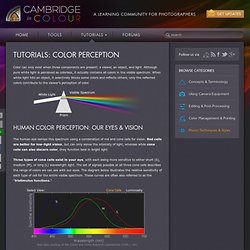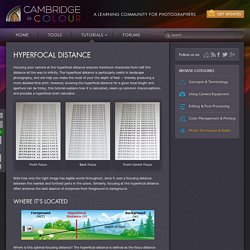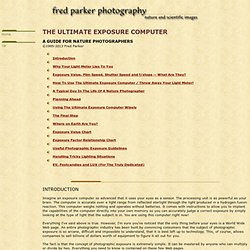

WIR: Table of Contents. True reasons for Full Frame. The true reasons for a full frame camera – White Paper – Tutorials – Color Perception. Color can only exist when three components are present: a viewer, an object, and light.

Although pure white light is perceived as colorless, it actually contains all colors in the visible spectrum. When white light hits an object, it selectively blocks some colors and reflects others; only the reflected colors contribute to the viewer's perception of color. The human eye senses this spectrum using a combination of rod and cone cells for vision. Rod cells are better for low-light vision, but can only sense the intensity of light, whereas while cone cells can also discern color, they function best in bright light. Three types of cone cells exist in your eye, with each being more sensitive to either short (S), medium (M), or long (L) wavelength light.
Raw data courtesy of the Colour and Vision Research Laboratories (CVRL), UCL. Note how each type of cell does not just sense one color, but instead has varying degrees of sensitivity across a broad range of wavelengths. Photography Links – Adobe Photoshop Lightroom « M&M's Musings. Hi There: A while back I did a post on photography sites that I visit daily or at least with some regularity.

I also have a page on ‘Becoming a Better Photographer‘ that links to about fifty photographers’ websites. Anyway, I use Tweetcaster and TweetDeck to manage my Twitter account, and through that I receive all tweets related to Adobe Photoshop Lightroom. I seem to be sending the same links to people with regard to Lightroom questions, so I thought I’d add them all in here. NB: I won’t even pretend that this list encompasses EVERY page devoted to Lightroom; it doesn’t. Also, there are new pages being created all the time. For more information you might want to read our ‘Lightroom, File Management and Metadata‘ post. _____ Update (December 18, 2013) Lightroom 5.3 and ACR 8.3 were officially released recently. Discussing How to calibrate your camera and adapter in M42 Lenses and DSLR's. Headlights2 says: When you did buy an adapter you will need to perform two tasks 1: Calibration of the viewfinder diopter 2: Shimming the adapter.

When done you will be much and much happier with your manual lens [ Shot with EOS 30D 55 mm SMC takumar f. 1.8 + 20 mm extension tube, @ f 5.6. Handheld focused at the bottum of the txt. Focus test chart for checking at close range:focustestchart.com/focus21.pdf 1: Calibration of the viewfinder diopter Very important when you start to use the adapter is to calibrate the viewfinder diopter. Best methode for is this one i am aware of is suggested by SteveFE: Quote: " SteveFE Pro User says: The way I calibrate the dioptre is this (when manual focussing you need your viewing eye to be relaxed and focussed at infinity or you'll get serious pain quite soon, as well as bad focus): Both eyes open, one to the finder, one admiring the view.
Hope this helps! A Flexible Depth of Field Calculator. A depth of field calculator is a useful photographic tool for assessing what camera settings are required to achieve a desired level of sharpness.

For a background on what everything here means, also see the tutorial on depth of field. Note: CF = "crop factor" (commonly referred to as the focal length multiplier) In order to calculate the depth of field, one needs to first decide on what will be considered acceptably sharp. More specifically, this is called the maximum circle of confusion (CoC), and is based on the camera sensor size (camera type), viewing distance and print size.
Understanding Your Camera’s Hyperfocal Distance. Focusing your camera at the hyperfocal distance ensures maximum sharpness from half this distance all the way to infinity.

The hyperfocal distance is particularly useful in landscape photography, and will help you make the most of your the depth of field — thereby producing a more detailed final print. However, knowing the hyperfocal distance for a given focal length and aperture can be tricky; this tutorial explains how it is calculated, clears up common misconceptions, and provides a hyperfocal chart calculator. Front Focus Back Focus Front-Center Focus Note how only the right image has legible words throughout, since it uses a focusing distance between the nearest and furthest parts in the scene. Ultimate Exposure Computer. Imagine an exposure computer so advanced that it uses your eyes as a sensor.

The processing unit is as powerful as your brain. The computer is accurate over a light range from reflected starlight through the light produced in a hydrogen fusion reaction. This computer weighs nothing and operates without batteries. It comes with instructions to allow you to implant the capabilities of the computer directly into your own memory so you can accurately judge a correct exposure by simply looking at the type of light that the subject is in.
You are using this computer right now! Everything I've said above is true. The fact is that the concept of photographic exposure is extremely simple. Knowledge of photographic exposure is essential to controlling the creative side of the photographic process. 1975: First digital camera. * Photography.